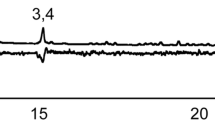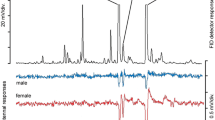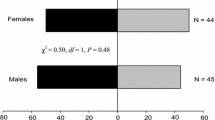Abstract
Headspace volatiles were collected from undamaged foliage of carrot,Daucus carota, a host-plant species of the black swallowtail butterfly,Papilio polyxenes. The volatiles were fractionated over silica on an open column, and the fractions were tested in behavioral assays withP. polyxenes females in laboratory experiments. The polar fractions, as well as the total mixture of volatiles, increased the landing frequency and the number of eggs laid on model plants with leaves bearing contact-oviposition stimulants. The nonpolar fraction, containing the most abundant compounds in carrot odor, was not stimulatory. Gas Chromatographic (GC) separation of the fractions was coupled with electroantennogram (EAG) recordings to identify the compounds perceived byP. polyxenes females. The EAG activity corresponded to the behavioral activity of the fractions. None of the nonpolar compounds, identified as various monoterpenes, evoked a major EAG response, but several constituents of the polar fractions elicited high EAG responses. Sabinene hydrate (both stereoisomers), 4-terpineol, bomyl acetate, and (Z)-3-hexenyl acetate were identified by GC-MS as active compounds.
Similar content being viewed by others
References
Bergström, G., Appelgren, M., Borg-Karlson, A.-K., Groth, I., Strömberg, S. andStrömberg, S. 1980. Studies on natural odoriferous compounds (XXII): Techniques for the isolation/enrichment of plant volatiles in the analysis ofOphris orchids (Orchidaceae).Chem. Scr. 16:173–180.
Blau, W.S. 1981. Life history variation in the black swallowtail butterfly.Oecologia 48:116–122.
Buttery, R.G., Seifert, R.M., Guadagni, D.G., Black, D.R. andLing, L.C. 1968. Characterization of some volatile constituents of carrots.J. Agric. Food Chem. 16:1009–1015.
Clark, L.G. andDennehy, T.J. 1988. Host-finding and oviposition behavior of grape berry moth.Entomol. Exp. Appl. 47:223–230.
Cronin, D.A. andStanton, P. 1976. 2-Methoxy-3-sec-butylpyrazine-an important contributor to carrot aroma.Sci. Food Agric. 27:145–151.
Davies, N.W. 1990. Gas Chromatographic retention indices of monoterpenes and sesquiterpenes on methyl silicone and Carbowax 20M phases.J. Chromatogr. 503:1–24.
Dobson, H.E.M. 1991. Analysis of flower and pollen volatiles, pp. 231–251,in H.F. Linskens and J.F. Jackson (eds.). Modern Methods of Plant Analysis. New Series, Volume 12, Essential Oils and Waxes. Springer-Verlag, Berlin.
Douwes, P. 1968. Host selection and host finding in the egg-laying female ofCidaria albulata L. (Lep. Geometridae).Opusc. Entomol. 33:233–279.
Feeny, P., Rosenberry, L. andCarter, M. 1983. Chemical aspects of oviposition behavior in butterflies, pp. 27–76,in S. Ahmad (ed.) Herbivorous Insects. Academic Press, New York.
Feeny, P., Sachdev, K., Rosenberry, L. andCarter, M. 1988. Luteolin 7-O-(6″-O-malonyl)-β-D-glucoside and (trans-chlorogenic acid: oviposition stimulants for the black swallowtail butterfly.Phytochemistry 27:3439–3448.
Feeny, P., Städler, E., Åhman, I. andCarter, M. 1989. Effects of plant odor on oviposition by the black swallowtail butterfly,Papilio polyxenes (Lepidoptera: Papilionidae).J. Insect Behav. 2:803–827.
Formacek, V. andKubeczka, K.-H. 1982. Essential Oils Analysis by Capillary Gas Chromatography and Carbon-13 NMR Spectroscopy. John Wiley & Sons, New York.
Guerin, P.M. andVisser, J.H. 1980. Electroantennogram responses of the carrot fly,Psila rosae, to volatile plant components.Physiol. Entomol. 5:111–119.
Guerin, P.M., Städler, E. andBuser, H.-R. 1983. Identification of host plant attractants for the carrot fly,Psila rosae.J. Chem. Ecol. 9:843–861.
Hamilton-Kemp, T.R., Andersen, R.A., Rodriguez, J.G., Loughrin, J.H. andPatterson, C.G. 1988. Strawberry foliage headspace vapor components at periods of susceptibility and resistance toTetranychus urticae Koch.J. Chem. Ecol. 14:789–796.
Hansson, B.S., Van Der Pers, J.N.C. andLöfqvist, J. 1989. Comparison of male and female olfactory cell response to pheromone compounds and plant volatiles in the turnip moth,Agrotis segetum.Physiol. Entomol. 14:147–155.
Landolt, P.J. 1989. Attraction of the cabbage looper to host plants and host plant odour in the laboratory.Entomol. Exp. Appl. 53:117–124.
Leather, S.R. 1987. Pine monoterpenes stimulate oviposition in the pine beauty moth,Panolis flammea.Entomol. Exp. Appl. 43:295–303.
Ma, W.-C., andSchoonhoven, L.M. 1973. Tarsal contact chemosensory hairs of the large white butterfly,Pieris brassicae and their possible role in oviposition behavior.Entomol. Exp. Appl. 16:343–357.
Masada, Y. 1976. Analysis of Essential Oils by Gas Chromatography and Mass Spectrometry. John Wiley & Sons, New York.
McLafferty, F.W. andStauffer, D.B. 1989. The Wiley/NSB Registry of Mass Spectral Data. John Wiley & Sons, New York.
Nishida, R. andFukami, H. 1989. Oviposition stimulants of an Aristolochiaceae-feeding swallowtail butterfly,Atrophaneura alcinous.J. Chem. Ecol. 15:2565–2575.
Nishida, R., Ohsugi, T., Kokubo, S. andFukami, H. 1987. Oviposition stimulants of citrusfeeding swallowtail butterfly,Papilio xuthus L.Experientia 43:342–344.
Palaniswamy, P., Gillott, C., andSlater, G.P. 1986. Attraction of diamondback moths,Plutella xylostella (L.) (Lepidoptera: Plutellidae), by volatile compounds of canola, white mustard, and faba bean.Can. Entomol. 118:1279–1285.
Papaj, D.R. 1986. Conditioning of leaf-shape discrimination by chemical cues in the butterfly,Battus philenor.Anim. Behav. 34:1281–1288.
Phelan, P.L., Roelofs, C.J., Youngman, R.R. andBaker, T.C. 1991. Characterization of chemicals mediating ovipositional host-plant finding byAmyelois transitella females.J. Chem. Ecol. 17:599–613.
Ramaswamy, S.B. 1988. Host finding by moths: Sensory modalities and behaviours.J. Insect Physiol. 34:235–249.
Rausher, M.D. 1978. Search image for leaf shape in a butterfly.Science 200:1071–1073.
Reed, D.K., Mikolajczak, K.L. andKrause, C.R. 1988. Ovipositional behavior of lesser peachtree borer in presence of host-plant volatiles.J. Chem. Ecol. 14:237–252.
Renwick, J.A.A. andRadke, C.D. 1987. Chemical stimulants and deterrents regulating acceptance or rejection of crucifers by cabbage butterflies.J. Chem. Ecol. 13:1771–1775.
Saxena, K.N. andGoyal, S. 1978. Host-plant relations of the Citrus butterflyPapilo demoleus L.: Orientational and ovipositional responses.Entomol. Exp. Appl. 24:1–10.
Simon, P.W., Lindsay, R.C. andPeterson, C.E. 1980. Analysis of carrot volatiles collected on polymer traps.J. Agric. Food Chem. 28:549–552.
Southwell, I.A. andStiff, I.A. 1989. Ontogenetical changes in monoterpenoids ofMelaleuca alternifolia leaf.Phytochemistry 28:1047–1051.
Städler, E. 1974. Host plant stimuli affecting oviposition behavior of the eastern spruce budworm.Entomol. Exp. Appl. 17:176–188.
Städler, E. 1984. Contact chemoreception, pp. 3–35,in W.J. Bell and R.T. Cardé (eds.). Chemical Ecology of Insects. Chapman & Hall, London.
Städler, E. 1992. Behavioral responses of insects to plant secondary compounds, pp. 45–88,in M.R. Berenbaum and G.A. Rosenthal (eds.). Herbivores: Their Interaction with Secondary Plant Metabolites. Academic Press, New York.
Städler, E. andBuser, H.-R. 1984. Defense chemicals in leaf surface wax synergistically stimulate oviposition by a phytophagous insect.Experientia 40:1157–1159.
Tollsten, L. andBergström, G. 1988. Headspace volatiles of whole plants and macerated plant parts ofBrassica andSinapis.Phytochemistry 27:4013–4018.
Vaidya, V.G. 1969. Investigations on the role of visual stimuli in the egg-laying and resting behaviour ofPapilio demoleus L. (Papilionidae, Lepidoptere).Anim. Behav. 17:350–355.
Varo, P.T. andHeinz, D.E. 1970. Volatile components of cumin seed oil.J. Agric. Food Chem. 18:234–238.
Visser, J.H. 1986. Host odour perception in phytophagous insects.Annu. Rev. Entomol. 31:121–144.
Wallbank, B.E. andWheatley, G.A. 1976. Volatile constituents from cauliflower and other crucifers.Phytochemistry 15:763–766.
Whitman, D.W. andEller, F.J. 1990. Parasitic wasps orient to green leaf volatiles.Chemoecology 1:69–75.
Wiklund, C. 1984. Egg-laying patterns in butterflies in relation to their phenology and visual apparency and abundance of their host plants.Oecologia 63:23–29.
Author information
Authors and Affiliations
Rights and permissions
About this article
Cite this article
Baur, R., Feeny, P. & Städler, E. Oviposition stimulants for the black swallowtail butterfly: Identification of electrophysiologically active compounds in carrot volatiles. J Chem Ecol 19, 919–937 (1993). https://doi.org/10.1007/BF00992528
Received:
Accepted:
Issue Date:
DOI: https://doi.org/10.1007/BF00992528




